Extended Land Registry Extract (Nota Simple) - Spain
Request your Land Registry Extract to the Land Registry with our Urgent Service, and get all the benefits and additional information included in the Extended Land Registry Extract
What is an Extended Land Registry Extract (Nota Simple)?
It's a Land Registry Extract from a property in Spain (in Spanish "Nota Simple") issued by the Land Registry (in Spanish "Registro de la Propiedad") including additional information:
- Cadastre Information (profile)
- Building report by Dato Capital (except Basque Country and Navarre)
- Business data about the owners and related companies, by Dato Capital
Here are each Extended Land Registry elements explained:
1. Land Registry Extract (Nota Simple)
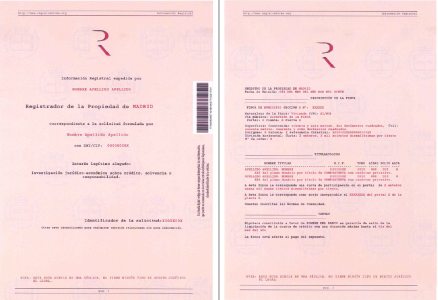
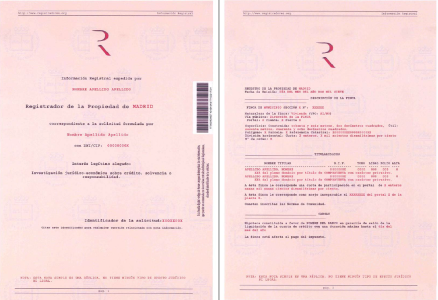
The Land Registry Extract (Nota Simple) is an informational document that contains the Registry information regarding a real estate property, such a flat, apartment, house, villa, land, lot or estate. The document length is usually two or three pages, but it can be longer if the property has a complex structure. This information is stored in the form of entries. The most common are:
1.1 Registry and Applicant information
It shows the name of the Land Property Registrar (in Spanish "Registrador de la Propiedad"), and the contact details for the Land Registry, including address and phone number, along with the name and ID of the Applicant who filed the request to the Land Registry (Registro de la Propiedad)
1.2 Exact identification of the property or estate
In order to identify the estate or property different data may appear:
1.2.1 Registry Data: They identify the property or estate in a classic way, ie Town, Name of the Land Registry, Property Number (in Spanish "Número de finca"), Section, Sub-property (in Spanish: "Sub-finca"), Duplicate. In addition Volume (Tomo), Book (Libro) and Folio may appear.
1.2.2 Address: It shows building address data (street and number) In case the property is an apartment located in a condo, apartment building, etc.. (with horizontal property division), the floor, stairs, door, etc.. are shown as well. If the property is a house (detached or semi-detached), the address is enough.
1.2.3 IDUFIR: The IDUFIR code it's the Unique Identifier of Registry Property (in Spanish "Identificador Único de Finca Registral"), a code that allows to locate a property exactly in the Land Registry. This code is unique per property, and it doesn't change over time. It was invented to have an unique identification, more convenient than registry data. Each regional Land Registry assigns it automatically to each property. It was first used in 2008, and it consists of 14 digits (a number). It's similar to the ID for people, or VAT Number for companies, but for properies or estates.
1.2.4 Cadastre Reference (in Spanish: "Referencia Catastral"): It's a code generated by the Directoriate General for Cadastre (under the Ministry of Finances), that uniquely identifies a property or estate, although it can change over time. It consists of 20 alphanumeric characters. It's the identification of the property or estate for tax purposes, and it appears in the property tax (in Spanish "Impuesto de Bienes Inmuebles IBI") issued by the city councils.
1.3 Description of the property or estate
In this section the property and its characteristics are described, starting with its type, ie land, lot, business space, facility, flat, apartment, building, house or villa, and its nature (rural or urban property), built area, number of rooms and adjoining properties. The adjoining properties (north, south, east, west) sometimes include ownership information as well. This description varies a lot from one property to another, and it can be more or less detailed depending on the age of the property or the particular Land Registry where it is inscribed.
1.4 The identity of the owners of the property or estate
In the Land Registry Extract the name of the owner (or owners) is shown. Also the name of person (or people) with rights on the property is shown too. In some extracts the National ID of the owners is shown as well, or the VAT Number in case the owners are companies. When multiple owners, the percentage of each one is shown. And for each owner, the registry related data (Volume/Tome, Book/Libro, Folio), date of purchase, and name of the authorizing Notary are shown too.
1.5 Property charges and mortgages
If the property or estate has charges or mortgages, they appear in this section, with associated date, bank or financial entity, along with amount, interests, fees, authorizing Notary, etc.... Fiscal issues, embargos, seizures, usufructs, easements, etc... may appear as well. This information can be very useful in cases of public properties, creditors of an estate, and it provides an overview of the rights of the owners on the property.
1.6 Other data
Depending on the property and its particular characteristics, other information regarding the rights of the owners on the property may appear, along with information of the issue date of the Land Registry Extract, and data about the existence of documents pending release.
2. Cadastre profile
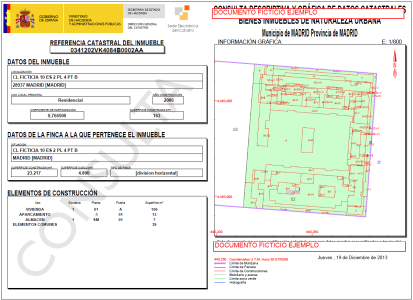

The cadastre profile it's a summary of the information stored in the Cadastre for the property or estate. This document contains:
- Basic property data (Datos del Inmueble): Location (Localización), Main Purpose (Uso Local Principal), Year Bult (Año de Construcción), Building Share Ratio (Coeficiente de participación en la finca matriz), and Built Area (Superficie Construida)
- If applicable: Source property / Building Data (Datos de la finca a la que pertenece el inmueble): Location (Situación), Built Area (Superficie Construida), Land Area (Superficie Suelo), Property Type (Tipo de Finca)
- If applicable: Built Elements (Elementos de construcción): A list with all the built elements and for each one, the following data: Purpose (Uso), Staris (Escalera), Floor (Planta), Door (Puerta), and built area in square meters (Superficie)
- Graphical information: A floor plan of the property or estate is included, in a variable escale. The different floors are shown per zone.
3. Building Report


The Building Report by Dato Capital includes data related to the dimensional characteristics of the building and the properties it contains. Depending on the building dimensions and the property distribution complexity the report may have different data. In the case of lands or lots these information may be limited, as it may happen also with detached or semi-detached small houses.
These data include:
- Comparison of Cadastre built area against Land Registry built area
- Built area percentages of the built units of the building (shared areas, parkings, etc...)
- Number of floors and stairs, Floor Area Ratio, Latitude and Longitude, Elevation above sea level.
- Building purposes, main and secondary, including breakdown of each purpose.
- Average built areas, per purpose.
- Comparison of areas of the target property against averages of the building.
- Building Floor data breakdown
- Building Stairs data breakdown
- Location map
- Aerial picture
- Property sketch
4. Owners appointments in companies Report
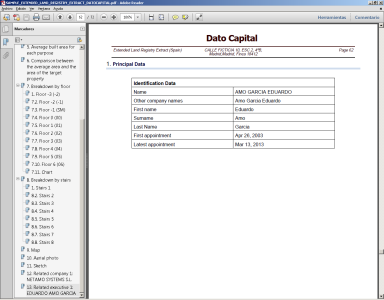

For each owner who has appointments in companies in the last years, we include an Executive Report by Dato Capital, with details of the appointments and resignations, along with other people who held positions in similar dates, and information about the companies.
5. Related companies Report
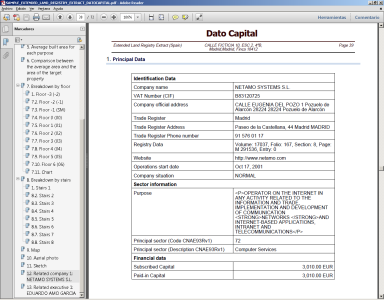

For each company mentioned in the Land Registry Extract, we include a report with relevant data about them.
Why should I want a Land Registry Extract? What is the purpose of a "Nota Simple"?
A Land Registry Extract (Nota Simple) is essential when buying a property in Spain, in order to know the real owner and charges or mortgages of the property. It's very useful also to verify the areas and real characteristics of the property or estate. For example the house can have a pending mortgage, not mentioned by the seller, a land can have an unknown easement, or the actual owner may be a different person (from the information supplied by the seller)
As a Land Registry Extract it has a merely informative value, in order to go to a court a certification is needed, this a different document, signed by the Property Registrar.
Why should I indicate the reason for the request?
It's legally required to show a legitimate interest to access the Land Registry information, that's why we offer different options, they are:
Research on property details, owners, and charges
This option is recommended when you want to know details of the property or estate. These details include constructive limitations, usufructs, easements, suitability for building. In general, you select this option when you want details about the property related rights.
Research on solvency, credit and responsibility
You select this option when the main interest of the request is to know the owners solvency, in order to rent another property to the owners, or grant a loan to them.
Research on purchase, prosecution or property rights
If the main interest of the request is the possible purchase or renting of the target property, this is the correct option. This is also the option in case of requesting a loan and the loan's guarantee is associated to the property.
The applicant holds property rights
You select this option if you are the property owner, because with the resulting Land Registry Extract you can prove your ownership to other institutions.
What information do I need to request a Extended Land Registry Extract?
Locating property by IDUFIR
The most accurate way to locate a property it's done with the IDUFIR code (in Spanish: "Identificador Único de Finca Registral), a 14 digit number.
Locating property by Property Number / Registry Data
If you don't know the IDUFIR, another accurate way to locate the property is using the Property Number (Número de Finca) (and Sub-property/Subfinca, Section/Sección if applicable), with the Land Registry number (in large cities there are many Land Registries), also with the Town / Municipality and Province. Optionally you can locate the property with the registry data of Volume (Tomo), Book (Libro), Folio and Section (Sección).Locating property by address
Locating property only by full address is usually difficult but it can be done. It's mandatory to enter type and name of street, exact street number (with possible dupliacte number), stairway, floor and door along with neighourhood and zone. Any other information that helps locating the property must be entered. City council where the property is registered and province must be entered as well.
Locating property by owner name
It makes easier to locate the property if full names of the current or past owners are included, including their national Id's if they are people or VAT Numbers if they are companies.
Locating property by cadastral reference, relation between Cadastre and Land Registry in Spain
Although many of the Land Registry Extracts include information about the property cadastre reference, this doesn't mean that you can locate a property using the cadastre reference. Cadastre reference can't be used to locate or find a property or estate.In Spain, the Land Registry and the Cadastre are different organizations, the Land Registry it's under the Ministry of Justice, and it's meant to handle the legal nature of the properties, land and estates, while the Cadastre it's under the Ministry of Finances, and it's meant to handle the tax situation of the properties. These two different organizations work in coordination with each other, in an effort to synchronize all the modifications and transactions that take place every day in the real estate world. As a result of this, the cadastre reference is incorporated to the Land Registry files, and the Cadastre knows the Property Number (Número de finca) of the properties.
It's important to note that the inscription of a house, building, land, etc... in the Land Registry is not mandatory in Spain. In most cases it's done because of the legal security it provides, because it's the best legal way to verify the ownership of a property. Because of that, there are many properties in Spain that are not inscribed in any Land Registry, but in the Cadastre. The Cadastre contains information about all the properties in Spain except in the Basque Country and Navarre regions, they have their own Cadastres.La superficie real, la que aparece en el Catastro, y la que aparece en el Registro de la Propiedad pueden no coincidir. Por diferentes motivos, los propietarios de terrenos o inmuebles deciden en ocasiones declarar una superficie inferior, y es por ello que en muchas ocasiones existen diferencias de superficie o incluso de forma de la parcela. En este sentido, existe una coordinación entre el sistema de mapas del Catastro (que cubre toda España salvo el País Vasco) y el sistema de mapas del Registro de la Propiedad, las bases gráficas Registrales.
The real built area, the one that appears in the Cadastre, and the one that appears in the Land Registry may not be the same. For different reasons, property owners in Spain decide sometimes to declare less area, and because of that, built area differences may exist, even shape differences. Regarding this matter, there is a coordination between the map system of the Cadastre and the map system of the Land Registry (registry graphic bases)
Can I see an example of Extended Land Registry Extract?
Yes, you can see an example in the following link
What happens in the property can not be located?
In this case we would contact you by email to obtain additional information to locate the property, in order to obtain the Land Registry Extract. If we are unable to locate it we will return the amount of the report minus 5 EUR (plus VAT) of processing fee.

